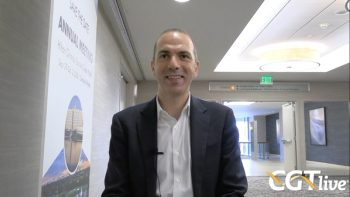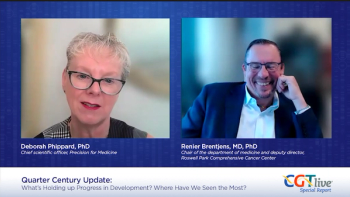
Tabelecleucel Efficacy Sustained in EBV-positive PTLD, as FDA Considers Application
With an FDA deadline pending in January, tabelecleucel remained safe and effective with longer follow-up for Epstein–Barr virus-associated post-transplant lymphoproliferative disease.
The efficacy and safety of tabelecleucel (tab-cel; Ebvallo) was confirmed with longer follow-up in updated findings for patients with Epstein–Barr virus (EBV)–associated post-transplant lymphoproliferative disease (PTLD) after failure of rituximab alone or with chemotherapy, according to a presentation open-label phase 3 ALLELE study (NCT03394365) showcased at
In the open-label study, the overall response rate (ORR) with tab-cel was 50.7%, which included a complete response (CR) rate of 28.0%. The median time to response was 1.1 months and the estimated duration of response was 23.0 months. In those who responded, the median progression-free survival (PFS) was 23.9 months, and the 12-month PFS rate was 74.2%. In all patients, the median overall survival (OS) with tab-cel was 18.4 months, and the 12-month OS rate was 55.7%.
"The ALLELE study data from this larger cohort confirm the previously reported data for both safety and efficacy of tab-cel. These are very promising outcomes," lead investigator Armin Ghobadi, MD, Division of Oncology, Washington University School of Medicine, said during a presentation of the results. "It is very safe. Few serious adverse events were found."
The FDA is currently reviewing a
Tab-cel is an off-the-shelf, non-genetically modified, allogenic EBV-specific T-cell immunotherapy. The cell is manufactured from healthy unrelated donors and cryopreserved in a biobank across several HLA profiles. The exact treatment is selected based on each patients HLA characterization and compatibility. No lymphodepletion or pretreatment is required.
Two groups of patients were assessed in the phase 3 study, namely those who received hematopoietic stem cell transplant (HCT) and failed rituximab (n = 26) and those with solid organ transplant (SOT) who either failed rituximab alone (subgroup A) or rituximab plus chemotherapy (subgroup B). Tab-cel was administered to both SOT and HCT groups at 2.0 x 106 cells/kg on days 1, 8, and 15, with clinical and radiologic assessment through day 28.
Patients could receive multiple treatment cycles until best response was achieved. If a non-response was seen, they also could be switched to another HLA lot. The median number of tab-cel cycles was 2 and the median number of infusions was 6. Overall, 3 lots of treatment were utilized. Most patients were infused in the outpatient setting (66.9%).
Patients in all groups had similar characteristics. The median age was 44.4 years. The ECOG performance score was 1, with a score of 2 or more seen in roughly a quarter of patients (26.5%). Extranodal disease was seen in three-fourths of patients (74.7%) and nearly all patients were deemed as high (42.6%) or intermediate rick (50%) by PTLD prognostic index. The PTLD morphology was primarily diffuse large B-cell lymphoma (69.3%).
The median time from diagnosis to first tab-cel administration was 4.6 months. The median number of prior therapies was 1 (range, 1-5), which included rituximab monotherapy for most patients (86.7%). Prior chemotherapy was received by 46.7% of patients and a combination of rituximab and chemotherapy was given to 37.3%. There were 3 patients who received prior immunotherapy. The most common transplant types were kidney (28.6%), heart (24.5%), and multivisceral (20.4%).
In the HCT group, the ORR was 50.0% with an estimated duration of response of 19.0 months. The CR rate was 30.8%. In the SOT group, the ORR was 51.0%, with a CR rate of 26.5%. The duration of response was 23.0 months.
In those who showed a response, the 12-month OS rate was 78.7% and the median OS was not yet reached. In those who did not respond, the 12-month OS rate was 28.2% and the median OS was 3.1 months.
Most treatment-emergent serious adverse events (TESAEs) were not treatment related, Ghobadi said. Overall, just 8% of patients experienced a TESAE related to tab-cel.
"For treatment-emergent AEs of special interest, there was no tumor flare, no cytokine release syndrome, no ICANS," said Ghobadi. "Graft-vs-host disease happened in 2 patients both in patients who received prior transplant. Bone marrow/organ rejection was seen in 3 patients, all were treated and it was resolved in these patients."
Atara Biotherapeutics, the developer of tab-cel, is also exploring the agent in the phase 2 EBVision trial (NCT04554914), which is examining tab-cel across several cohorts for EBV-positive diseases. If positive, findings from this multicohort study could support label expansion beyond PTLD, according to Atara's President and Chief Executive Officer Pascal Touchon in July 2024.3 The study was initiated in 2021 and has a primary completion date listed as June 2027.
For more coverage of ASH 2024,
References
1. Ghobadi A, Baiocchi R, Beitinjaneh AM, et al. Updated Clinical Results: A Multicenter, Open-Label, Phase 3 Study of Tabelecleucel for Solid Organ or Allogeneic Hematopoietic Cell Transplant Recipients with Epstein–Barr Virus-Driven Post Transplant Lymphoproliferative Disease after Failure of Rituximab or Rituximab Plus Chemotherapy. Presented at: ASH 2024 Annual Meeting & Exposition. December 7-10; San Diego, CA. Abstract #70.
2. Mahadeo KM, Baiocchi R, Beitinjaneh A, et al. Tabelecleucel for allogeneic haematopoietic stem-cell or solid organ transplant recipients with Epstein–Barr virus-positive post-transplant lymphoproliferative disease after failure of rituximab or rituximab and chemotherapy (ALLELE): a phase 3, multicentre, open-label trial. Lancet Oncol. 2024;25(3):376-387.
3. Atara Biotherapeutics Announces U.S. FDA Acceptance and Priority Review of the Biologics License Application for Tabelecleucel (Tab-cel®) for the Treatment of Epstein-Barr Virus Positive Post-Transplant Lymphoproliferative Disease. July 17, 2024. Accessed December 6, 2024. https://investors.atarabio.com/news-events/press-releases/detail/356/atara-biotherapeutics-announces-u-s-fda-acceptance-and
Newsletter
Stay at the forefront of cutting-edge science with CGT—your direct line to expert insights, breakthrough data, and real-time coverage of the latest advancements in cell and gene therapy.










































